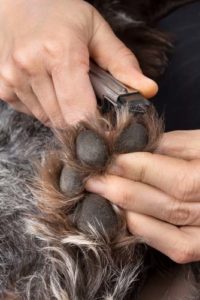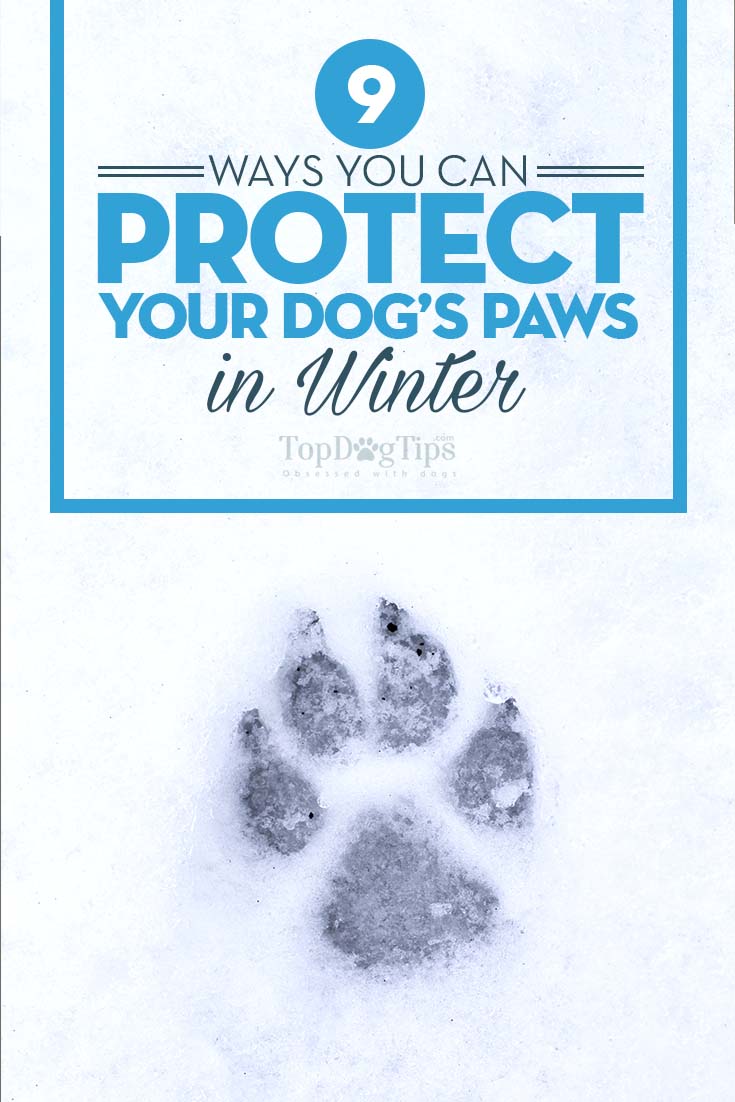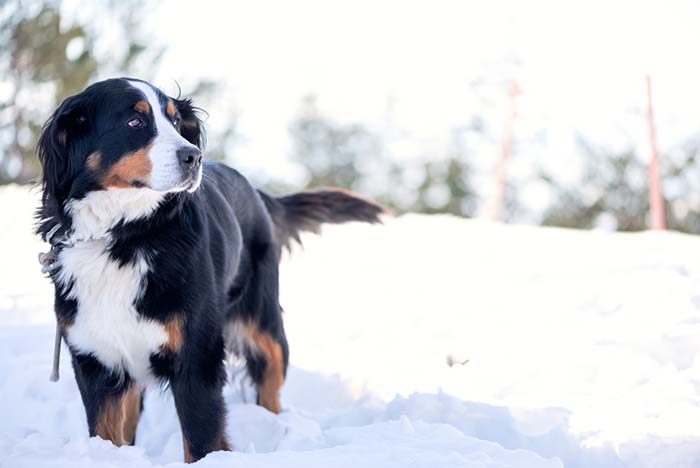Winter time is just around the corner, which means preparing your dog for cold weather. One thing many pet owners forget about is the health of oru canine's feet and proper dog paw care. Are you ready for, and do you know how to protect your dogs paws in winter? Here are some helpful tips.
When you take your dog outdoors during the winter, there are many ways their paws could be harmed. Exposure to cold air, chilly rain, sleet, icy roads, chemicals and salt on the pavement, and snow can cause paws to chap and lead to itchy, flaky skin.
While many pet owners use dog-friendly ice melts around their house, other areas outside of your home can be dangerous. If you live in an area where harmful chemicals are used to melt ice, those can not only seriously harm your dog's paws, but also poison your pet if he likes to lick his paws after exposure.
“Check your dog’s paws frequently for signs of cold-weather injury or damage, such as cracked paw pads or bleeding. Sudden lameness during a walk may be due to an injury or to ice accumulation between the dog’s toes.” – Dr Elisabeth Giedt, DVM (source)
Veterinarians often warn how deicers – chemical deicing agents often used in winter time – can cause problems ranging from simple sore paws to internal toxicity. Therefore, it is absolutely imperative that you know how to protect your dogs paws in the winter.
ALSO READ: The 5 Best Dog Coats for Dogs in Winter Cold
9 Tips on How to Protect Your Dogs Paws in Winter
1. Keep Your Dog Indoors Whenever Possible
The first and best tip on how to protect your dogs paws in winter is to keep them away from cold. When the temperatures hit low numbers, dogs can get cold just as we can. Keeping your dog outside during the winter all day everyday may be considered cruel and dangerous due to the risks of hypothermia, frostbite, and more.
When you're waling your dog in the winter time, try to not be outside too long. The longer your dog’s paws are exposed to the cold, the more likely they are to be damaged. The general rule is that if it is too cold for you to be outside, it is too cold for your dog to be outside. And same as in summer, never leave your dog alone in a car in low temperatures.
2. Avoid Ice Patches
When walking your dog in winter, try to avoid ice patches as there are several reasons why they can be dangerous to your dog’s paws. There is the risk of dogs falling and straining or injuring themselves, especially with dogs who are excited to be outside.
RELATED: 15 Ways to Keep Your Dog Healthy in the Fall
Aside from that, ice can break off in sharp pieces. This can cut your dog’s paws. Ice can stick to their paws and cause discomfort. If you’re walking your dog and come across an ice patch, you and your dog may be excited to play on it, but the best thing to do is avoid the patch altogether.
3. Moisturize Your Dog’s Paws
 Speaking of moisturizing your dog's paws, before you take your dog outside, massage petroleum jelly or dog protection wax onto their paws. This both moisturizes and protects your dog’s paws from dangerous chemical agents, ice and salt. This is one of the key tips on how to protect your dogs paws in winter.
Speaking of moisturizing your dog's paws, before you take your dog outside, massage petroleum jelly or dog protection wax onto their paws. This both moisturizes and protects your dog’s paws from dangerous chemical agents, ice and salt. This is one of the key tips on how to protect your dogs paws in winter.
Once you go back indoors, towel dry your dog’s paws and moisture once more to prevent flaking and chapping. There are separate dog paw balms you can use for indoors that will prevent their paws from cracking, itching, dryness and hyperkeratosis. If you notice your dog’s paws are chapped, continue moisturizing regularly as it will help heal them.
4. Consider Using Dog Booties (or Socks)
A lot of people laugh at the idea of having your dog wear booties, shoes, or socks when going outside, but they can provide great protection for your dog’s paws. In fact, more and more pet owners are choosing dog booties for different types of weather, whether it's hot summer days, rainy autumn walks or icy and snowy winter time.
Proper dog's paw protection will limit your dog’s contact with poisonous anti-freeze, ice-melting agents, and painful salt crystals. If you live in an area with snow or ice, you will likely come into contact with these and your dog's paws need some sort of protection. An alternative to dog shoes is usually protective waxes or dog socks. These will also prevent dirt and sand from being lodged between your dog’s bare toes, which can be painful.
“Boots can help protect paws from the snow and ice, but make sure they fit correctly, can be put on easily and will stay on, and have good traction.” – Prof. Susan Nelson, DVM (source)
Proper fit of dog booties is important. Here's a video guide and a step by step article on how to make sure a proper dog shoes fit and measure your dog for booties.
5. Wipe Your Dog’s Paws Off
Ice, snow, salt, and deicing chemicals found on the pavement can be extremely harmful for a dog’s paws. When you bring your dog inside, the first thing you should do is wash, clean and properly wipe his paws off. You can simply do this with a luke-warm water and a towel, or using a dog paw wash which makes the process a little easier.
A good paw washing session will prevent your Fido from licking anything harmful, such as chemicals, off themselves and will also prevent painful salt or dirt from becoming lodged in your dog's paws, eating away at his skin. Salt and dirt can cause extreme discomfort if ignored for a longer period.
6. Bathe Your Dog As Little As Possible During The Winter
 Something that will make your dog happier and relieve you from some grooming tasks is limiting the amount of bath time when the temperatures are low. Bathing your dog too often, especially in winter, can cause their skin and paws to become dry. So if you want an easy tip on how to protect your dogs paws in winter, that's the one.
Something that will make your dog happier and relieve you from some grooming tasks is limiting the amount of bath time when the temperatures are low. Bathing your dog too often, especially in winter, can cause their skin and paws to become dry. So if you want an easy tip on how to protect your dogs paws in winter, that's the one.
This is because frequent bathing can strip essential oils and increases the chance of flaking and dry skin. In winter, the weather is already making your dog's skin and coat dry, and bathing your dog will only complicate the matter. When you do have to bathe your dog, be sure to use moisturizing dog shampoos, preferably vet recommended ones.
7. Keep Your Home Humidified
When a dog goes from cold weather into dry heat, such as in your home, their paws could flake and chap more. Keeping your home humidified can help prevent this. You can do this by using a regular humidifier. These range anywhere from $100 to $500, depending on the model and what you need out of it.
If you don’t own a humidifier and aren't willing to buy one, you can simply try using your stove top to improve humidity around the house. Consistently boiling water will add moisture to the air. Also, if you leave the door open when you shower, the steam will work to humidify your home. These little tricks will only get you so far, however.
8. Keep Your Dog Well-Hydrated
During the wintertime, with all other variables staying consistent, your dog's body will burn through more energy/calories to keep themselves warm, which can also lead to getting dehydrated faster. To help with this, ensure your dog is always hydrated.
Monitor your dog's liquid intake and offer plenty of water. If your dog is staying outside most of the day, make sure you have heated dog water bowls that would not freeze in very low temperatures. This may not seem relevant, but overall health and hydration are another key aspect of knowing how to protect your dogs paws in winter.
You can also consider feeding your dog more frequently during the winter. If you notice any signs of dehydration on a consistent basis, you can switch to wet dog food brands, or mixing in a bit of wet food with their dry food. Wet food has more water than dry food, and therefore does more to hydrate your dog, which is helpful for dogs that refuse to drink plenty of water. This will protect their skin from dryness, and also helps their paws remain moisturized.
9. Keep Your Dog’s Nails Trimmed
 One important tip rarely mentioned on how to protect dogs paws in the winter is the importance of having their nails trimmed at all times. Trimming your dog's nails the proper way is also important. Determining how often to trim your dog’s nails depends on your dog's breed, so if you aren’t sure, simply ask your veterinarian.
One important tip rarely mentioned on how to protect dogs paws in the winter is the importance of having their nails trimmed at all times. Trimming your dog's nails the proper way is also important. Determining how often to trim your dog’s nails depends on your dog's breed, so if you aren’t sure, simply ask your veterinarian.
Long nails on the dog cause make your pooch slip on ice easier. There is also the risk of nails getting torn or breaking off, which can be extremely painful for your dog. Aside from it being painful, it adds the risk of infection and with all the chemicals around in winter, further complications are not far along the way.
Winter weather can be extremely brutal on your dog’s paws. There is the risk of drying, chapping, and discomfort. Toxic chemicals used to melt ice can harm your dog. They can be absorbed through their paws and licked off by the dog. Prolonged exposure to cold weather can cause frostbite in the paws. Knowing how to protect your dogs paws in winter is one of the more important canine health aspects to keep in mind.
READ NEXT: Why Do Dogs Sleep More In Winter Time?














